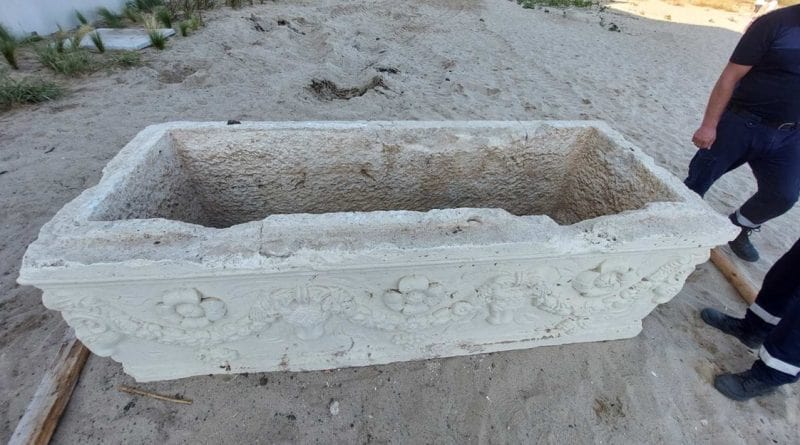
Roman sarcophagus was found on a beach near Varna in Bulgaria
An ancient Roman sarcophagus was discovered by chance on a beach near the resort of St. Constantine and Helena in the city of Varna, one of Bulgaria’s most popular tourist destinations.
The resort of St. Constantine and Helena is the first officially recognized Black Sea resort and is located 8 km north of the city of Varna, in the middle of an area of outstanding natural beauty.
Ancient Varna is a Thracian settlement. Later it became an Ancient Greek colony and in 15 AD it became part of the Roman Empire. The Roman baths or spas in Varna were built in the late 2nd century and used until the late 3rd century.
A former police officer vacationing in the area noticed the sarcophagus while walking on the beach and reported it to the Varna Fifth District Department. The unattended artifact was located near a newly built but still inactive complex.
The find was reported to the local authorities and was quickly placed under protection by the Varna Archaeological Museum and the regional office of the Cultural Heritage Protection Directorate of the Ministry of Culture.
According to Bulgarian National Television, after a preliminary examination by a local representative of the Varna Archaeological Museum and the Cultural Heritage Protection Directorate of the Ministry of Culture, it was determined that the sarcophagus most likely dates from the Roman period, specifically the second or third century AD.

The sarcophagus measures approximately 90 x 235 x 75 cm (3 x 7.7 x 2.5 feet) and is decorated with elaborate relief ornaments. These include wreaths, leaves, grapes, animal heads, rosettes, labrys (double-edged axes) and other stylized ornaments characteristic of Roman funerary art.
According to the Bulgarian media outlet “24 Hours”, the sarcophagus may have been intended to be used as a table, as it has a modern marble lid with three niches. According to Milen Marinov, a restorer at the historical museum in Varna, experts suspect it was cut to fit the top and painted with facade paint, which is currently being cleaned.
Marinov had this to say about the ongoing investigation: “We want to see what is underneath, whether any of the original coloring remains, what technique was used to make it – we don’t have all the information to tell us whether the sarcophagus is real or not. We have just started, we can’t say anything for sure,” he said.
The investigation aims to determine whether the sarcophagus is an authentic Roman relic, a modified original or a contemporary artifact intended to resemble an antique. Marinov emphasized the difficulties in making such assessments, pointing out that there are many ways to artificially age objects so that they appear older than they actually are. This thorough analysis is crucial to verify the authenticity and historical value of the sarcophagus.
With the help of the staff of the Regional Department of Fire Safety and Civil Protection and heavy equipment, the artifact was transported to the Archaeological Museum in Varna for storage, where expert examinations will be carried out.
Cover Photo: Bulgaria Ministry of Interior
You may also like
- A 1700-year-old statue of Pan unearthed during the excavations at Polyeuktos in İstanbul
- The granary was found in the ancient city of Sebaste, founded by the first Roman emperor Augustus
- Donalar Kale Kapı Rock Tomb or Donalar Rock Tomb
- Theater emerges as works continue in ancient city of Perinthos
- Urartian King Argishti’s bronze shield revealed the name of an unknown country
- The religious center of Lycia, the ancient city of Letoon
- Who were the Luwians?
- A new study brings a fresh perspective on the Anatolian origin of the Indo-European languages
- Perhaps the oldest thermal treatment center in the world, which has been in continuous use for 2000 years -Basilica Therma Roman Bath or King’s Daughter-
- The largest synagogue of the ancient world, located in the ancient city of Sardis, is being restored











Leave a Reply